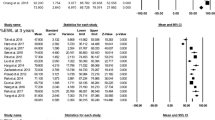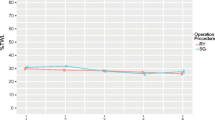Abstract
Purpose
Prevalence of obesity in Asia has been on the increasing trend, with corresponding increase in utilisation of bariatric surgery. The objective of this study was to examine differences in weight loss outcomes following bariatric surgery between Asian ethnicities.
Materials and Methods
A retrospective database review was conducted of patients undergoing primary laparoscopic sleeve gastrectomy between 2009 and 2013 in 14 centres from Singapore, Malaysia, Taiwan, Hong Kong, Japan, Korea, India, Australia, Switzerland, and the USA. All patients with available follow-up data at 12 months and 36 months post-surgery were included in this study. Outcome measures used were percentage excess weight loss (%EWL) and percentage total weight loss (%TWL). Differences in outcomes between ethnicities were analysed after adjusting for age, gender, baseline body mass index (BMI), and presence of diabetes.
Results
The study population (n = 2150) consisted of 1122 Chinese, 187 Malays, 309 Indians, 67 Japanese, 259 Koreans, and 206 Caucasians. 67.1% were female and 32.9% were male. Mean age was 37.1 ± 11.2 years. Mean pre-operative BMI was 40.7 ± 8.1 kg/m2. With the Caucasian population as reference, Japanese had the best %TWL (3.90, 95% CI 1.16–6.63, p < 0.05) and %EWL (18.55, 95% CI 10.33–26.77, p < 0.05) while the Malays had the worst outcomes. Both Chinese and Koreans had better %EWL but worse %TWL as compared to Caucasians and there were no significant differences with the Indian study group.
Conclusion
There are differences in weight loss outcomes following bariatric surgery between Asian ethnicities.

Similar content being viewed by others
References
(WHO) WHO. Obesity and overweight fact sheets. 2016. Available from: http://www.who.int/mediacentre/factsheets/fs311/en/.. Accessed 20 Mar 2018.
Ezzati M, Lopez AD, Rodgers A, et al. Selected major risk factors and global and regional burden of disease. Lancet (London, England). 2002;360(9343):1347–60.
Ni Mhurchu C, Rodgers A, Pan WH, et al. Body mass index and cardiovascular disease in the Asia-Pacific region: an overview of 33 cohorts involving 310 000 participants. Int J Epidemiol. 2004;33(4):751–8.
Karter AJ, Ferrara A, Liu JY, et al. Ethnic disparities in diabetic complications in an insured population. JAMA. 2002;287(19):2519–27.
McWilliams JM, Meara E, Zaslavsky AM, et al. Differences in control of cardiovascular disease and diabetes by race, ethnicity, and education: U.S. trends from 1999 to 2006 and effects of Medicare coverage. Ann Intern Med. 2009;150(8):505–15.
Finkelstein EA, DiBonaventura M, Burgess SM, et al. The costs of obesity in the workplace. J Occup Environ Med. 2010;52(10):971–6.
Ogden CL, Carroll MD, Kit BK, et al. Prevalence of childhood and adult obesity in the United States, 2011-2012. JAMA. 2014;311(8):806–14.
Skinner AC. Prevalence and trends in obesity and severe obesity among children in the United States, 1999-2012. JAMA Pediatr. 2014;168(6):561–6.
Freedman DS. Racial and ethnic differences in secular trends for childhood BMI, weight, and height. Obesity (Silver Spring, Md). 2006;14(2):301–8.
Rajput NN. Overweight and obesity in 4-5-year-old children in New Zealand: results from the first 4 years (2009-2012) of the B4School Check programme. J Paediatr Child Health. 2015;51(3):334–43.
Division EDC, Ministry of Health S. National Health Survey 2004. 2004. Available from: https://www.moh.gov.sg/content/moh_web/home/Publications/Reports/2005/national_health_survey2004.html. Accessed 20 Mar 2018.
Division EDC, Ministry of Health S. National Health Survey 2010. 2010. Available from: https://www.moh.gov.sg/content/dam/moh_web/Publications/Reports/2011/NHS2010%20-%20low%20res.pdf. Accessed 20 Mar 2018.
Registry SMI, Office NRoD, Ministry of Health S. Trends in acute myocardial infarction in Singapore 2007–2013. 2015. Available from: https://www.nrdo.gov.sg/docs/librariesprovider3/default-document-library/trends_in_acute_myocardial_infarction_in_singapore-2007-2013_web6ef607a5c9d76bafab5aff000014cdee.pdf?sfvrsn=0. Accessed 20 Mar 2018.
Registry SR, Office NRoD, Ministry of Health S. Singapore Renal Registry Annual Report 2015. 2016. Available from: https://www.nrdo.gov.sg/docs/librariesprovider3/default-document-library/singapore-renal-registry-annual-report.pdf?sfvrsn=0. Accessed 20 Mar 2018.
Registry SS, Office NRoD, Ministry of Health S. Stroke Registry Report 2014. 2016. Available from: https://www.nrdo.gov.sg/docs/librariesprovider3/default-document-library/stroke-report-2014.pdf?sfvrsn=0. Accessed 20 Mar 2018.
Clinical guidelines on the identification, evaluation, and treatment of overweight and obesity in adults—the evidence report. National Institutes of Health. Obesity research. 1998;6 Suppl 2:51S–209S.
Poirier PP. Bariatric surgery and cardiovascular risk factors: a scientific statement from the American Heart Association. Circulation (New York, NY). 2011;123(15):1683–701.
Dixon JB, Zimmet P, Alberti KG, et al. Bariatric surgery: an IDF statement for obese type 2 diabetes. Diabet Med. 2011;28(6):628–42.
Admiraal WM. Ethnic differences in weight loss and diabetes remission after bariatric surgery: a meta-analysis. Diabetes Care. 2012;35(9):1951–8.
Admiraal WM, Bouter K, Celik F, et al. Ethnicity influences weight loss 1 year after bariatric surgery: a study in Turkish, Moroccan, South Asian, African and ethnic Dutch patients. Obes Surg. 2013;23(9):1497–500.
Anderson WA. Weight loss and health outcomes in African Americans and whites after gastric bypass surgery. Obesity (Silver Spring, Md). 2007;15(6):1455–63.
Buffington CK. Ethnic differences in obesity and surgical weight loss between African-American and Caucasian females. Obes Surg. 2006;16(2):159–65.
Capella RF, Capella JF. Ethnicity, type of obesity surgery and weight loss. Obes Surg. 1993;3(4):375–80.
Cheung LK, Lal LS, Chow DS, et al. Racial disparity in short-term outcomes after gastric bypass surgery. Obes Surg. 2013;23(12):2096–103.
Madan AK, Whitfield JD, Fain JN, et al. Are African–Americans as successful as Caucasians after laparoscopic gastric bypass? Obes Surg. 2007;17(4):460–4.
Buchwald H. Consensus conference statement. Surg Obes Relat Dis. 2005;1(3):371–81.
Lim KGA. Review of adult obesity research in Malaysia. Med J Malaysia. 2016;71(Suppl 1):1–19.
Kahn HS, Williamson DF, Stevens JA. Race and weight change in US women: the roles of socioeconomic and marital status. Am J Public Health. 1991;81(3):319–23.
Kumanyika SK, Obarzanek E, Stevens VJ, et al. Weight-loss experience of black and white participants in NHLBI-sponsored clinical trials. Am J Clin Nutr. 1991;53(6 Suppl):1631s–8S.
Wing RR. Effectiveness of a behavioral weight control program for blacks and whites with NIDDM. Diabetes Care. 1996;19(5):409–13.
Foster GD, Wadden TA, Swain RM, et al. Changes in resting energy expenditure after weight loss in obese African American and white women. Am J Clin Nutr. 1999;69(1):13–7.
Washburn RA. Leisure time physical activity: are there black/white differences? Prev Med. 1992;21(1):127–35.
Weinsier RL, Hunter GR, Zuckerman PA, et al. Energy expenditure and free-living physical activity in black and white women: comparison before and after weight loss. Am J Clin Nutr. 2000;71(5):1138–46.
Health Promotion Board S. Report of the National Nutrition Survey 2004. Available from: https://www.hpb.gov.sg/docs/default-source/default-document-library/national-nutrition-survey-2004.pdf?sfvrsn=82daeb72_0. Accessed 20 Mar 2018.
Sobal J, Stunkard AJ. Socioeconomic status and obesity: a review of the literature. Psychol Bull. 1989;105(2):260–75.
Ball K, Crawford D. Socioeconomic status and weight change in adults: a review. Social science & medicine (1982). 2005;60(9):1987–2010.
Monteiro CA, Moura EC, Conde WL, et al. Socioeconomic status and obesity in adult populations of developing countries: a review. Bull World Health Organ. 2004;82(12):940–6.
Zhang Q, Wang Y. Trends in the association between obesity and socioeconomic status in U.S. adults: 1971 to 2000. Obes Res. 2004;12(10):1622–32.
Sundquist J, Johansson SE. The influence of socioeconomic status, ethnicity and lifestyle on body mass index in a longitudinal study. Int J Epidemiol. 1998;27(1):57–63.
Dryson E, Metcalf P, Baker J, et al. The relationship between body mass index and socioeconomic status in New Zealand: ethnic and occupational factors. N Z Med J. 1992;105(936):233–5.
Wang Y. Cross-national comparison of childhood obesity: the epidemic and the relationship between obesity and socioeconomic status. Int J Epidemiol. 2001;30(5):1129–36.
Singapore, Ministry of Community Development Y, Sports. Progress of the Malay community in Singapore since 1980. Singapore: Ministry of Community Development, Youth and Sports; 2007.
Wong HZ, Lim WY, Ma SS, et al. Health screening behaviour among Singaporeans. Ann Acad Med Singap. 2015;44(9):326–34.
Bower JF, Deshaies Y, Pfeifer M, et al. Ethnic differences in postprandial triglyceride response to a fatty meal and lipoprotein lipase in lean and obese African American and Caucasian women. Metab Clin Exp. 2002;51(2):211–7.
Bower JF, Vadlamudi S, Barakat HA. Ethnic differences in in vitro glyceride synthesis in subcutaneous and omental adipose tissue. Am J Physiol Endocrinol Metab. 2002;283(5):E988–93.
Nicklas BJ, Dennis KE, Berman DM, et al. Lifestyle intervention of hypocaloric dieting and walking reduces abdominal obesity and improves coronary heart disease risk factors in obese, postmenopausal, African-American and Caucasian women. J Gerontol A Biol Sci Med Sci. 2003;58(2):181–9.
Nicklas BJ, Berman DM, Davis DC, et al. Racial differences in metabolic predictors of obesity among postmenopausal women. Obes Res. 1999;7(5):463–8.
Yoshiike N, Miyoshi M. Epidemiological aspects of overweight and obesity in Japan—international comparisons. Nihon Rinsho Jpn J Clin Med. 2013;71(2):207–16.
Senauer B, Masahiko G. Why is the obesity rate so low in Japan and high in the U.S.? Some possible economic explanations. 2006.
Nishitani N, Sakakibara H, Akiyama I. Eating behavior related to obesity and job stress in male Japanese workers. Nutrition. 2009;25(1):45–50.
Otsuka R, Yatsuya H, Tamakoshi K, et al. Perceived psychological stress and serum leptin concentrations in Japanese men. Obesity. 2006;14(10):1832–8.
Hayashi F, Takimoto H, Yoshita K, et al. Perceived body size and desire for thinness of young Japanese women: a population-based survey. Br J Nutr. 2007;96(6):1154–62.
Inoue M, Toyokawa S, Miyoshi Y, et al. Degree of agreement between weight perception and body mass index of Japanese workers: MY Health Up Study. J Occup Health. 2007;49(5):376–81.
Author information
Authors and Affiliations
Corresponding author
Ethics declarations
Conflict of Interest
The authors declare that they have no conflict of interests.
Statement of Informed Consent
No formal consent was required as this was a retrospective study.
A Statement of Human and Animal Rights
This study has been approved by the Institutional Review Board of each institution and all procedures were conducted in accordance with the 1964 Helsinki declaration and its later amendments or comparable ethical standards.
Additional information
Publisher’s Note
Springer Nature remains neutral with regard to jurisdictional claims in published maps and institutional affiliations.
Rights and permissions
About this article
Cite this article
Koh, Z.J., Tai, B.C., Kow, L. et al. Influence of Asian Ethnicities on Short- and Mid-term Outcomes Following Laparoscopic Sleeve Gastrectomy. OBES SURG 29, 1781–1788 (2019). https://doi.org/10.1007/s11695-019-03716-8
Published:
Issue Date:
DOI: https://doi.org/10.1007/s11695-019-03716-8




